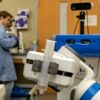In a series of studies, scientists from the NeptunLab at the University of Freiburg (Germany) have pushed the potential of 2-photon polymerization 3D-printing (2PP 3D-printing) beyond existing limits. Having demonstrated their ability to print complex platinum 3D microstructures with an astonishing sub-micron resolution in 2021, this year the team succeeded in producing similar structures made of tungsten as well as embedded microfluidic chips with single μm resolution at unprecedented speed.
Leading scientist Manuel Luitz used a NanoOne 2PP 3D-printer from UpNano GmbH (Austria). Having successfully recruited Luitz for UpNano, the company will continue to redefine the rules of feasibility for 2PP 3D-printing.
Two major limitations for a wider application of high-resolution 2PP 3D-printing are the printing speed and the available materials for the necessary photopolymerization. Now, Luitz, during his time at the Laboratory of Process Technology (NeptunLab) at the University of Freiburg in Germany, has significantly reduced these limitations in research spanning several years.
The results of this work have been published in three successive papers in the journals Advanced Materials, Advanced Engineering Materials, and the latest in Advanced Materials Technology.
Clever chip channel cleaning
In this latest development, Luitz and colleagues have defined a development scheme for single-micron embedded microfluidic chips using the NanoOne printer from UpNano GmbH (Austria). This printer is the fastest 2PP 3D-printer on the market, capable of high-resolution 3D-printing over an astonishing 15 orders of magnitude. Using the printer’s power, the team was able to print a chip that could be connected via a chip-to-world interface to a pressure-driven pump.
“This is a breakthrough in microfluidic chip manufacturing,” explains Luitz, “because one of the major obstacles to high-resolution 3D printing of microfluidic chips is washing the embedded channels free of uncured material.” This made it possible to produce meander chips with channel lengths of up to 20 cm, droplet generator chips and a cell sorting chip based on deterministic lateral displacement with column diameters of 30 μm and column spacing of 4 μm.
“Microfluidic chips with centimeter dimensions and μm resolution are thus printable in a reasonable time frame of less than 12 hours using the NanoOne,” explains Luitz.
Taming tungsten
Before this, Luitz used the NanoOne printer for a very different purpose, one that would significantly expand the range of materials that can be 3D-printed with 2PP. He “tamed” tungsten and tungsten carbide for a high-resolution additive manufacturing process. This was not an easy task as both materials are known for their extreme hardness (Mohs scale 9.0) and heat resistance (melting point > 3,400°C), making them difficult to work with. However, high-resolution objects made from tungsten and its carbides are in high demand for applications such as emitter tips, probes, microtools, as well as metamaterials or catalysis.
“Using a NanoOne printer,” explains Luitz, “we were able to design a manufacturing process based on an organic-inorganic photo-resin containing tungsten ions. The polymer parts are then thermally debound and reduced, leaving tungsten parts with a final resolution of 2 μm and tungsten carbide parts with a resolution of 7 μm.”
Luitz’s success at the NeptunLab at “Institut für Mikrosystemtechnik –IMTEK” in “taming” tungsten for 2PP 3D-printing with the NanoOne did not come out of the blue. The team had previously achieved a similar result with platinum. In fact, they were able to produce free-standing nanopillars as well as complex 3D platinum microstructureswith a resolution of 300 nm. Such small structures will find use in various engineering applications, including metamaterials and catalysis, where the large surface area and physicochemical properties of platinum are highly desirable.
More information:
Manuel Luitz et al, Fabrication of Embedded Microfluidic Chips with Single Micron Resolution Using Two‐Photon Lithography, Advanced Materials Technologies (2023). DOI: 10.1002/admt.202300667
Manuel Luitz et al, High‐Resolution Patterning of Organic–Inorganic Photoresins for Tungsten and Tungsten Carbide Microstructures, Advanced Engineering Materials (2023). DOI: 10.1002/adem.202201927
Manuel Luitz et al, High Resolution Patterning of an Organic–Inorganic Photoresin for the Fabrication of Platinum Microstructures, Advanced Materials (2021). DOI: 10.1002/adma.202101992
Provided by
UpNano GmbH
Citation:
New possibilities of 2PP 3D-printing for complex microstructures (2023, November 7)



